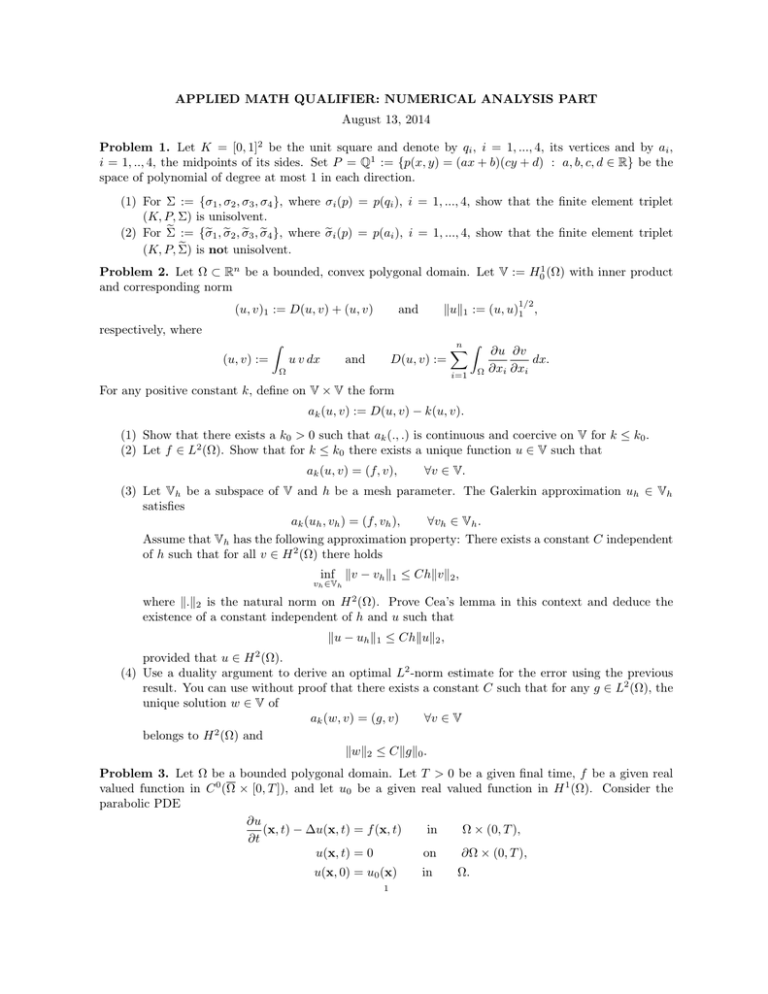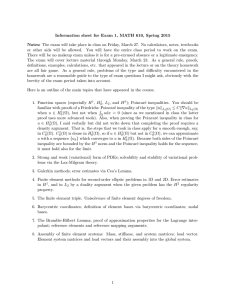APPLIED MATH QUALIFIER: NUMERICAL ANALYSIS PART August 13, 2014
advertisement

APPLIED MATH QUALIFIER: NUMERICAL ANALYSIS PART
August 13, 2014
Problem 1. Let K = [0, 1]2 be the unit square and denote by qi , i = 1, ..., 4, its vertices and by ai ,
i = 1, .., 4, the midpoints of its sides. Set P = Q1 := {p(x, y) = (ax + b)(cy + d) : a, b, c, d ∈ R} be the
space of polynomial of degree at most 1 in each direction.
(1) For Σ := {σ1 , σ2 , σ3 , σ4 }, where σi (p) = p(qi ), i = 1, ..., 4, show that the finite element triplet
(K, P, Σ) is unisolvent.
e := {e
(2) For Σ
σ1 , σ
e2 , σ
e3 , σ
e4 }, where σ
ei (p) = p(ai ), i = 1, ..., 4, show that the finite element triplet
e is not unisolvent.
(K, P, Σ)
Problem 2. Let Ω ⊂ Rn be a bounded, convex polygonal domain. Let V := H01 (Ω) with inner product
and corresponding norm
(u, v)1 := D(u, v) + (u, v)
1/2
kuk1 := (u, u)1 ,
and
respectively, where
Z
(u, v) :=
u v dx
and
D(u, v) :=
Ω
n Z
X
i=1
Ω
∂u ∂v
dx.
∂xi ∂xi
For any positive constant k, define on V × V the form
ak (u, v) := D(u, v) − k(u, v).
(1) Show that there exists a k0 > 0 such that ak (., .) is continuous and coercive on V for k ≤ k0 .
(2) Let f ∈ L2 (Ω). Show that for k ≤ k0 there exists a unique function u ∈ V such that
ak (u, v) = (f, v),
∀v ∈ V.
(3) Let Vh be a subspace of V and h be a mesh parameter. The Galerkin approximation uh ∈ Vh
satisfies
ak (uh , vh ) = (f, vh ),
∀vh ∈ Vh .
Assume that Vh has the following approximation property: There exists a constant C independent
of h such that for all v ∈ H 2 (Ω) there holds
inf kv − vh k1 ≤ Chkvk2 ,
vh ∈Vh
where k.k2 is the natural norm on H 2 (Ω). Prove Cea’s lemma in this context and deduce the
existence of a constant independent of h and u such that
ku − uh k1 ≤ Chkuk2 ,
provided that u ∈ H 2 (Ω).
(4) Use a duality argument to derive an optimal L2 -norm estimate for the error using the previous
result. You can use without proof that there exists a constant C such that for any g ∈ L2 (Ω), the
unique solution w ∈ V of
ak (w, v) = (g, v)
∀v ∈ V
2
belongs to H (Ω) and
kwk2 ≤ Ckgk0 .
Problem 3. Let Ω be a bounded polygonal domain. Let
valued function in C 0 (Ω × [0, T ]), and let u0 be a given
parabolic PDE
∂u
(x, t) − ∆u(x, t) = f (x, t)
∂t
u(x, t) = 0
u(x, 0) = u0 (x)
1
T > 0 be a given final time, f be a given real
real valued function in H 1 (Ω). Consider the
in
Ω × (0, T ),
on
∂Ω × (0, T ),
in
Ω.
2
We focus on a second order semi-discretization in time. Accept as a fact that the above parabolic problem
has one and only one solution that is sufficiently smooth and satisfies for all v ∈ H01 (Ω)
Z
Z
Z
∂u
(x, t)v(x) dx +
∇u(x, t) · ∇v(x) dx =
f (x, t)v(x) dx
Ω ∂t
Ω
Ω
and u(0, x) = u0 (x) a.e. in Ω.
(1) Let N ≥ 2 be an integer, set τ := T /N , tn := nτ for 0 ≤ n ≤ N , and
1
f n−1/2 (x) := (f (x, tn−1 ) + f (x, tn )) .
2
Then, starting from u0 = u0 , consider the following problem: For each 1 ≤ n ≤ N , given
un−1 ∈ H01 (Ω) find un ∈ H01 (Ω) satisfying for any v ∈ H01 (Ω)
Z
Z
1
un (x) + un−1 (x)
(un (x) − un−1 (x))v(x)dx +
∇(
) · ∇v(x) dx
τ Ω
2
Ω
Z
=
f n−1/2 (x) v(x) dx.
Ω
Prove that the above problem has one and only one solution un ∈ H01 (Ω).
(2) Show that for any n = 1, ..., N there holds
n
n
ui + ui−1 2
C2 X
1X
τ k∇(
)kL2 (Ω) ≤ ku0 k2L2 (Ω) + Ω
τ kf i−1/2 k2L2 (Ω) ,
kun k2L2 (Ω) +
2 i=1
2
2 i=1
where CΩ is the Poincaré constant.
(3) Show that for all v ∈ H01 (Ω)
Z
Z
u(x, tn ) + u(x, tn−1 )
1
(u(x, tn ) − u(x, tn−1 ))v(x) dx +
∇
· ∇v(x) dx
τ Ω
2
Ω
Z
Z
=
f n−1/2 (x)v(x) dx +
E n−1/2 (x) v(x) dx,
Ω
Ω
where
E n−1/2 (x) :=
1
1
(u(x, tn ) − u(x, tn−1 )) −
τ
2
∂u
∂u
(x, tn )) +
(x, tn−1 )) .
∂t
∂t
(4) Use the Taylor expansion formula
1
1
f (s) = f (a) + f 0 (a)(s − a) + f 00 (a)(s − a)2 +
2
2
Z
s
(s − t)2 f 000 (t)dt
a
following bound for E n−1/2
3 2
∂ 3 u d xd t,
Ω ∂t
and similar formula for the derivative to deduce the
Z tn Z
kE n−1/2 k2L2 (Ω) ≤ Cτ 3
tn−1
where C is a constant independent of N and u.
(5) Denote the errors by en (x) := u(., tn ) − un (.), n = 1, ..., N , and prove using the results obtained
in the previous steps that there exists a constant C independent of N and u such that
!1/2
!1/2
Z T Z 3 2
N
∂ 1X
en + en−1 2
n 2
2
sup ke kL2 (Ω) +
τ k∇(
)kL2 (Ω)
≤ Cτ
.
3 u d xd t
2 n=1
2
1≤n≤N
0
Ω ∂t











